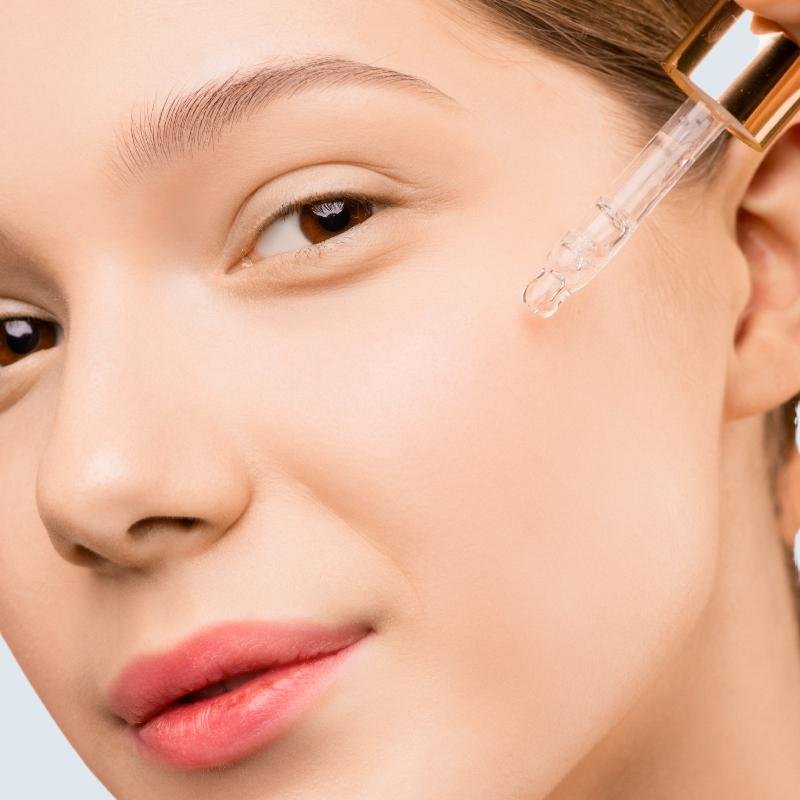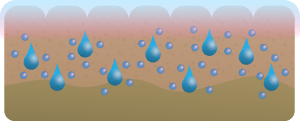
Hyaluronic Acid
Benefits of Hyaluronic Acid What’s the hype about Hyaluronic Acid? Hyaluronic acid is a clear substance that is naturally occurring within our skin, joints and
Hyaluronic acid is a naturally occurring substance which is found in connective tissues within the body, particularly in the eyes, joints and skin. In these tissues, your body utilises it as a lubricant, however it has natural properties which make it useful as a humectant in cosmetics as it helps your skin retain hydration.


A topical product containing hyaluronic acid is applied to the skin’s surface. It attracts water molecules from its surroundings and binds to them.

To avoid the hyaluronic acid from drawing water away from the skin’s surface…

As the product soaks, the hyaluronic acid penetrates the skin and draws the water with it.

…lock it in with moisturiser.
Hyaluronic acid is one of the key ingredients in many skincare products as it is very good at keeping your skin hydrated and acts as a natural sponge by retaining water. In fact, it can bind up to one thousand times its weight in water, thereby preventing trans-epidermal water loss (TEWL) and is used in a wide range of moisturising creams, lotions and serums, achieving a more plumped up, hydrated and luminous appearance. Maintaining a high water-content in your skin is crucial to your whole skin care regime, because when the skin is dehydrated, it cannot function properly and can take on a rough, flaky texture. Poorly hydrated skin is less able to maintain an intact skin barrier, leaving the skin more susceptible to damage from environmental sources and more prone to skin conditions such as dry skin, dermatitis, rosacea and acne.
Hyaluronic acid can help make your skin feel softy and more springy, allowing it to stretch and flex and reducing the appearance of fine lines and wrinkles. It has also been proven to promote communication between skin cells and helps in the healing process.
Over time your body’s natural reserves of hyaluronic acid decline, mostly because of age, but environmental factors such as smoking can accelerate this process. Topical products containing hyaluronic acid such as serums or moisturisers can help to replenish these depleted stores so you may continue to reap the benefits.
Hyaluronic acid was first isolated in the 1930s from bovine vitreous humor, this is a colourless, gel-like fluid which occupies the space between the lens of the eye and the retina, and in this case was extracted from a cow. The highest concentration of hyaluronic acid recorded from a natural source was from a rooster comb, which is the fleshy crest upon the head of a rooster (up to 7500µg per gram of tissue); this has been a widely used source of animal-extracted hyaluronic acid for years.
However, the process of animal extraction is generally not preferred to produce hyaluronic acid for a multitude of reasons:
Production of hyaluronic acid by way of bacterial fermentation of glucose has been evolving for over two decades. Initially, Group A and Group C Streptococci (which naturally secrete hyaluronic acid) were cultivated in fermenters, and the product was extracted before the hyaluronic acid was purified. This process is more efficient than animal extraction, however these bacteria also produced toxins. As a result, the gene responsible to produce hyaluronic acid was isolated and alternative bacteria (Bacillus, Agrobacterium, E. Coli and Lactococcus) were genetically modified to include this gene. This meant that they could produce hyaluronic acid with good yields and a much better purity.
Showing 11–12 of 12 results

Benefits of Hyaluronic Acid What’s the hype about Hyaluronic Acid? Hyaluronic acid is a clear substance that is naturally occurring within our skin, joints and